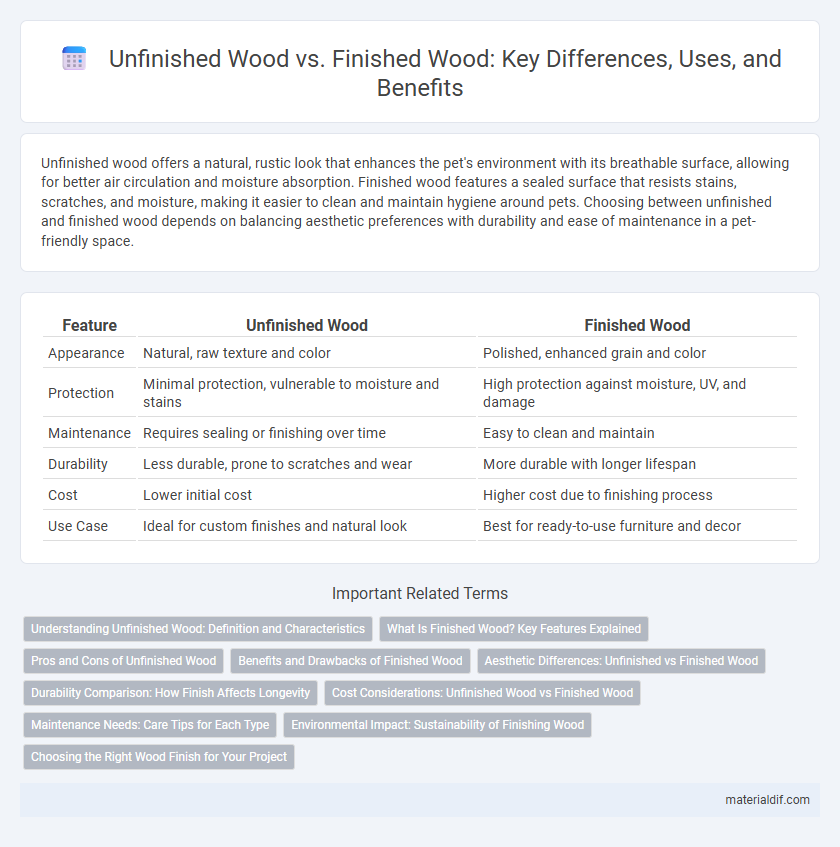Unfinished wood offers a natural, rustic look that enhances the pet's environment with its breathable surface, allowing for better air circulation and moisture absorption. Finished wood features a sealed surface that resists stains, scratches, and moisture, making it easier to clean and maintain hygiene around pets. Choosing between unfinished and finished wood depends on balancing aesthetic preferences with durability and ease of maintenance in a pet-friendly space.
Table of Comparison
| Feature | Unfinished Wood | Finished Wood |
|---|---|---|
| Appearance | Natural, raw texture and color | Polished, enhanced grain and color |
| Protection | Minimal protection, vulnerable to moisture and stains | High protection against moisture, UV, and damage |
| Maintenance | Requires sealing or finishing over time | Easy to clean and maintain |
| Durability | Less durable, prone to scratches and wear | More durable with longer lifespan |
| Cost | Lower initial cost | Higher cost due to finishing process |
| Use Case | Ideal for custom finishes and natural look | Best for ready-to-use furniture and decor |
Understanding Unfinished Wood: Definition and Characteristics
Unfinished wood refers to lumber that has not been coated with any protective sealants, stains, or paints, preserving its natural texture and appearance. This type of wood is highly porous, which makes it more susceptible to moisture absorption, warping, and staining but allows for better customization during finishing. Common characteristics include a rougher surface, visible grain patterns, and increased vulnerability to environmental factors compared to finished wood.
What Is Finished Wood? Key Features Explained
Finished wood is wood that has undergone a protective coating process using varnish, paint, stain, or sealant to enhance durability and aesthetic appeal. This treatment improves resistance to moisture, scratches, and UV damage while highlighting the natural grain patterns and colors of the wood. Finished wood surfaces are smoother, easier to clean, and often used in furniture, flooring, and cabinetry for a polished, long-lasting look.
Pros and Cons of Unfinished Wood
Unfinished wood offers greater customization potential by allowing for personalized staining, painting, or sealing to match specific design preferences and environmental needs. It tends to be more affordable initially, but requires regular maintenance to protect against moisture, insects, and wear, making it less durable compared to finished wood. Its porous surface enhances adhesion for paints and finishes but leaves it vulnerable to damage if left untreated.
Benefits and Drawbacks of Finished Wood
Finished wood offers enhanced durability and resistance to moisture, stains, and scratches due to protective coatings like varnish, lacquer, or polyurethane. This treatment preserves the wood's appearance over time and makes cleaning easier, but it can obscure the natural texture and grain, limiting the wood's aesthetic authenticity. Finished wood may require periodic refinishing to maintain its protective layer, adding maintenance costs and time compared to unfinished wood.
Aesthetic Differences: Unfinished vs Finished Wood
Unfinished wood showcases its natural grain, texture, and raw color, providing a rustic and organic aesthetic that highlights the wood's intrinsic characteristics. Finished wood, coated with stains, varnishes, or paints, offers a polished look with enhanced color depth, sheen, and uniformity that protects the surface from moisture and wear. The choice between unfinished and finished wood significantly influences the visual appeal and ambiance of interior and exterior spaces.
Durability Comparison: How Finish Affects Longevity
Finished wood significantly outperforms unfinished wood in durability, as sealants protect the surface from moisture, UV rays, and physical wear. Unfinished wood absorbs water, leading to swelling, warping, and eventual decay when exposed to environmental elements. Applying finishes like varnish or polyurethane extends wood longevity by creating a protective barrier against fungal growth, insects, and surface abrasion.
Cost Considerations: Unfinished Wood vs Finished Wood
Unfinished wood typically costs less upfront than finished wood because it requires additional labor, materials, and time for sanding, staining, and sealing. Finished wood includes the expenses for coatings like polyurethane or varnish, which increase durability but raise the overall price. When budgeting, consider that unfinished wood offers customization potential but may incur higher long-term costs due to maintenance and refinishing needs.
Maintenance Needs: Care Tips for Each Type
Unfinished wood requires regular sealing and treatment to protect against moisture and pests, with periodic sanding and oiling to maintain its natural beauty. Finished wood demands routine dusting, gentle cleaning with appropriate wood cleaners, and occasional polishing to preserve its protective coating and sheen. Both types benefit from controlling indoor humidity and avoiding direct exposure to harsh environmental elements to extend their lifespan.
Environmental Impact: Sustainability of Finishing Wood
Unfinished wood has a lower immediate environmental impact because it requires no chemical treatments or coatings, reducing the release of volatile organic compounds (VOCs) and toxic substances. Finished wood often involves the application of varnishes, paints, or sealants that contain synthetic chemicals, which can contribute to pollution during manufacturing and disposal. Sustainable finishing options, such as natural oils or water-based finishes, improve durability and lifespan while minimizing ecological harm compared to traditional finishes.
Choosing the Right Wood Finish for Your Project
Selecting the right wood finish depends on the project's purpose, exposure, and desired appearance. Unfinished wood offers flexibility for customization and natural aesthetics but requires sealing to protect against moisture and wear. Finished wood provides durability and enhanced grain beauty through stains, paints, or varnishes, making it ideal for high-traffic or outdoor applications.
Unfinished Wood vs Finished Wood Infographic

 materialdif.com
materialdif.com